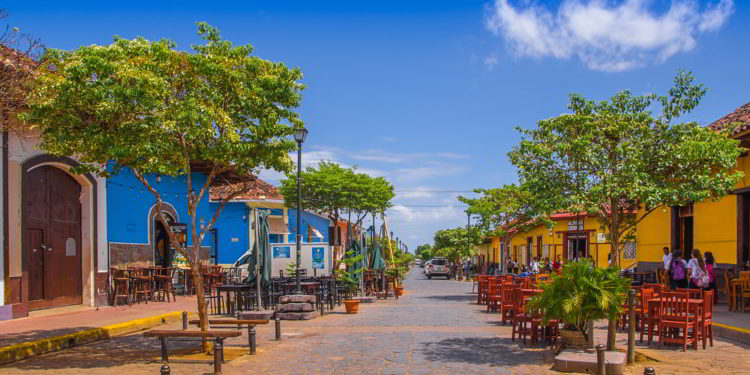I just reviewed a listing for a trendy, one-bedroom loft in downtown Sacramento, California. It was reasonably priced for this market at US$655,000… which, at 1,125 square feet, comes out to US$582 per square foot… or, as we normally measure it internationally, US$6,264 per square meter.
I also recently completed our annual property survey, where I take a snapshot of what properties cost in various markets of interest around the world.
Here’s some of what I learned:
I can get a beautiful Spanish-colonial home in Granada, Nicaragua, for an average of just US$783 per meter (US$73 per square foot).
A rental condo in the heart of downtown Santa Cruz, Bolivia, sells for US$913 per meter (US$85 per SF).
In the Dominican Republic, an apartment in downtown Santo Domingo—with its lucrative rental returns—averages US$1,179 per meter (US$110 per SF).
In the beautiful highland city of Arequipa, Peru, a home will cost about US$1,254 per meter (US$117 per SF).
And a home that’s near the historic center in colonial Cuenca, Ecuador, will set you back US$1,258 per meter (US$117 per SF).
But here’s a shocking reality…
I can buy one property each in all five of these cities, and still not be up to the cost of that loft in Sacramento. All five properties above total up to US$5,387 per meter… almost US$900 per meter less than the single Sacramento loft.
That loft may well be a good investment… but should you give up five properties around the world to get it?
Let’s take a look at the five least-expensive markets in the survey.
Granada: Still in a class by itself
Granada, Nicaragua
Cost per square meter: US$783
Price change in 2022: Increased 57.5%
Property trades in: USD
Granada still takes the prize for the least-expensive property in the survey at just US$783 per meter (US$73 per square foot), even though the prices went up by an amazing 57.5%. Inventories are low this year, and premium colonials are becoming scarce… yet prices are still nowhere near as high as most colonial cities.
I’ve long maintained that Granada is the best place in the Americas to buy a Spanish-colonial home, and they’re still a remarkable bargain.
Granada offers a number of advantages to the property buyer.
First, the homes in Granada are relatively small and manageable by colonial-home standards, so they’re easy to fix up and maintain. Also, the town is clean and friendly, and the weather is always warm. Granada is a small city of about 130,000 people. Over the years, there are few places where I’ve felt more comfortable and “at home” than Nicaragua.
Desirability of a property is measured by its distance to the central plaza and cathedral, so stay within a few blocks of the plaza if you can. And in recent years, Calle La Calzada—which begins at the square—has also become a popular attraction, with restaurants, cafes, and nightlife. These days, proximity to La Calzada will attract buyers as readily as proximity to the square.
Colonial homes start at around US$70,000. Expect to pay around US$85,000 for a fixer-upper near the square, and over US$130,000 for something that’s ready to go. Large colonials with center courtyards and pools in premium areas will go for US$190,000 and upwards to US$400,000.
Don’t expect a quick capital gain in Granada. It’s best suited to those who want a Spanish-colonial home, in a colonial city, at a good price.
Santa Cruz, Bolivia, remains under the investor’s radar
Santa Cruz, Bolivia
Cost per square meter: US$913
Price change in 2022: Decreased 14%
Property trades in: USD
Average prices dropped in Santa Cruz this year, but the numbers tell a more complicated story. The average apartment in the two-bedroom inventory today is about 20% larger than last year. And because larger apartments typically cost less per square meter than smaller ones, the average cost per meter is down.
Overall, I’d say the market was almost flat, with the larger units accounting for much of the decline in cost per square meter.
Like Granada, Santa Cruz is a Spanish-colonial city, founded in 1561. But unlike Granada, it’s a large city of about 1.7 million people.
And frankly, if all you want is a Spanish-colonial lifestyle, there are dozens of options in the Americas that are more convenient than Santa Cruz, which lies seven hours from Miami.
But for an investment, I like it for a few reasons.
Unlike the more popular, high-altitude cities of Sucre and La Paz, Santa Cruz is the center of Bolivia’s wealth. For a rental that caters to business travelers (or the many government workers), this is where you want to be.
Santa Cruz is one of the world’s fastest-growing cities, producing about one-third of Bolivia’s GDP and receiving most of Bolivia’s Foreign Direct Investment.
I especially like the opportunity for geopolitical and economic diversification in Santa Cruz because it is well-outside the U.S. sphere of influence. It’s a great Plan B location, despite its cumbersome residency process.
Properties in Santa Cruz are priced in U.S. dollars, so you won’t be exposed to exchange rate volatility.
It’s worth noting that Bolivia has the world’s second-largest reserve of lithium… the critical element used in batteries that enable everything from cell phones to electric cars. Over a quarter of the world’s lithium is in Bolivia.
Santa Cruz extends outward from the city’s center, where you’ll find the cathedral and the center square, Plaza 24 de septiembre. If you look on a map, you’ll see there are roads that encircle the downtown, like concentric rings. And when looking at real estate, I like to stay within the segundo anillo (second ring), for walkability and proximity to the government offices and tourist sites. In this market, I’d focus on modern properties, rather than colonial-style homes.
Properties in this area of Santa Cruz are a nice size, with the two-bedroom units I reviewed averaging 106 square meters (1,136 SF). For a good rental, expect to spend around US$90,000, while a more upscale place for personal use will cost around US$110,000 or upward.
Santa Cruz, Bolivia, is a good Plan B location because it’s geopolitically distant from the United States, with the added benefit of a good market for income properties… non-U.S. income. And as you can see, the entry price is quite low.
A great time to invest in the Dominican Republic
Santo Domingo, DR
Cost per square meter: US$1,179
Price change in 2022: Decreased 22%
Property trades in: USD
Most of the world conjures images of swaying palms and white-sand beaches when they think of the Dominican Republic, but Santo Domingo is just as unique and special as the country’s beaches.
When it comes to Spanish-colonial cities, this is the original… the first. Founded around 1496 by the brother of Christopher Columbus (Bartolomé), Santo Domingo is the oldest European city in the Americas and the first seat of Spanish-colonial power in the New World.
But today’s Santo Domingo is more than a beautiful example of Spanish-colonial architecture and history. It’s also the cultural, financial, political, commercial, and industrial center of the DR, as well as its primary port. Santo Domingo—with a population of over 4 million—is also the most populous city in the Caribbean.
The average price of this year’s market inventory is down in Santo Domingo, by a healthy 22%. Many of the new, high-end buildings from previous surveys have been sold out, so the current inventory contains a mix of older and newer buildings.
At these prices, rental returns look promising in Santo Domingo, with some units approaching 10% (net of property taxes and HOA fees).
Historic Santo Domingo is beautiful, and I’m sure there’s a market for tourism-related income properties.
But my preference is to focus on the business traveler or the local entrepreneur who maintains a presence in Santo Domingo. These are my favorite tenants for an income property.
Apartments in Santo Domingo tend to run big… there are hundreds of them for sale with areas larger than 150 square meters (1,614 SF). So I had to do some digging to find something in a smaller, cost-efficient size. The bigger units can rent—I saw a 540-square-meter unit, valued at US$700,000, renting for US$3,200 per month—but the returns are not as good as the smaller units.
The Dominican Republic is also a fairly popular Plan B location, thanks to its convenient residency program and easy path to citizenship.
Cuenca, Ecuador: A bargain property mainstay for almost 20 years
Cuenca, Ecuador
Cost per square meter: US$1,258
Price change in 2022: Decreased 2%
Property trades in: USD
I moved to Cuenca in 2001, lived there for five years, and have returned many times since… so I can attest to the fact that it offers a great lifestyle with one of the lowest costs of living in the Americas. Today’s Cuenca is one of the world’s top retirement destinations, with thousands of North American and European expats in residence.
This former Inca capital was settled by the Spanish in the mid-1500s, and the walkable historic center still maintains its colonial charm. The influx of expats has changed the character of the city somewhat, but it has also brought a generous number of cafés, restaurants, and ethnic dining that was formerly unknown in Ecuador. Overall, for most people, Cuenca is a more enjoyable place to live than when I first saw it.
The town has over a half-million people, and enjoys a cool Andean climate with highs around 70°F (22°C) and lows around 50°F (10°C).
Prices were down very slightly in 2022, after a 15% uptick in 2021. At US$1,258 per meter—for good-quality homes and an enviable lifestyle—Cuenca is hard to beat in Latin America.
Most properties—especially rental properties—are judged by their distance to the town square or walkability to the historic center. So stay within that band if you can. If you’re buying a house in Cuenca to live there (rather than renting it out), then you’ll find nice properties in quite a few farther-flung neighborhoods.
If you’re planning to rent your property out, consider renting it long term. Cuenca is one of the few markets where long-term rental returns compare favorably with (or outperform) short-term returns. This is because most property owners want to spend at least part of the year in Cuenca, so they’re reluctant to take on long-term renters. This leaves a shortage in the long-term market.
A modern, convenient, two-bedroom apartment outside the historic center proper starts at about US$100,000. For a luxury apartment in a premium location, plan on spending over US$175,000 for around 100 square meters.
Lee Harrison
Senior Correspondent, Overseas Property Alert











